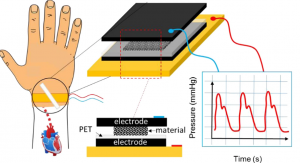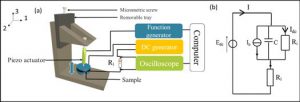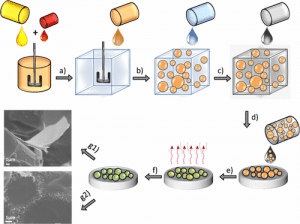Polymeric foams for flexible and highly sensitive low-pressure capacitive sensors
Mickaël Pruvost, Wilbert J Smit, Cécile Monteux, Philippe Poulin and Annie Colin, Dec 2019, Nature Flexible Electronics
 High sensitivity is a critical feature for flexible pressure sensors and a novel and low-cost emulsion method has been invented to make capacitive sensors with higher sensitivity. A team of CNRS scientists from France led by Prof Annie Colin develops an unconventional approach for flexible and highly sensitive low-pressure capacitive sensors based on carbon black filled foams. They embed the carbon black in Polydimethylsiloxane (PDMS) elastomer using a water-in-oil emulsion method, which achieves a large change of the permittivity associated to large changes in capacitance upon small compression forces. Consequently, the sensitivity exceeds 35 kPa-1, one order of magnitude higher than previous results. The team then demonstrates arterial pressure measurements and in deed the technique can be applied to much wider fields requiring low-cost and low-power consumption.
High sensitivity is a critical feature for flexible pressure sensors and a novel and low-cost emulsion method has been invented to make capacitive sensors with higher sensitivity. A team of CNRS scientists from France led by Prof Annie Colin develops an unconventional approach for flexible and highly sensitive low-pressure capacitive sensors based on carbon black filled foams. They embed the carbon black in Polydimethylsiloxane (PDMS) elastomer using a water-in-oil emulsion method, which achieves a large change of the permittivity associated to large changes in capacitance upon small compression forces. Consequently, the sensitivity exceeds 35 kPa-1, one order of magnitude higher than previous results. The team then demonstrates arterial pressure measurements and in deed the technique can be applied to much wider fields requiring low-cost and low-power consumption.
Read more: https://www.nature.com/articles/s41528-019-0052-6
Microporous electrostrictive materials for vibrational energy harvesting
Mickaël Pruvost, Wilbert J Smit, Cécile Monteux, Philippe Poulin and Annie Colin, Jul 2018, Multifonctionnal Materials
 We present electrostrictive materials with excellent properties for vibrational energy harvesting applications. The developed materials consist of a porous carbon black composite, which is processed using water-in-oil emulsions. In combination with an insulating layer, the investigated structures exhibit a high effective relative dielectric permittivity (up to 182 at 100 Hz) with very low effective conductivity (down to 2.53 10−8 S m−1). They can generate electrical energy in response to mechanical vibrations with a power density of 0.38 W m−3 under an applied bias electric field of 32 V. They display figures or merit for energy harvesting applications well above reference polymer materials in the field, including fluorinated co- and ter-polymers synthetized by heavy chemical processes. The production process of the present materials is based on non hazardous and low-cost chemicals. The soft dielectric materials are highly flexible (Young’s modulus of ~1 MPa) making them also suited for highly sensitive capacitive sensors.
We present electrostrictive materials with excellent properties for vibrational energy harvesting applications. The developed materials consist of a porous carbon black composite, which is processed using water-in-oil emulsions. In combination with an insulating layer, the investigated structures exhibit a high effective relative dielectric permittivity (up to 182 at 100 Hz) with very low effective conductivity (down to 2.53 10−8 S m−1). They can generate electrical energy in response to mechanical vibrations with a power density of 0.38 W m−3 under an applied bias electric field of 32 V. They display figures or merit for energy harvesting applications well above reference polymer materials in the field, including fluorinated co- and ter-polymers synthetized by heavy chemical processes. The production process of the present materials is based on non hazardous and low-cost chemicals. The soft dielectric materials are highly flexible (Young’s modulus of ~1 MPa) making them also suited for highly sensitive capacitive sensors.
Read more: https://iopscience.iop.org/article/10.1088/2399-7532/aab2ff
Giant electrostrictive response and piezoresistivity of emulsion templated nanocomposites
Alan Luna, Mickael Pruvost, Jinkai Yuan, Cécile Zakri, Wilfrid Neri, Cécile Monteux, Philippe Poulin and Annie Colin, Apr 20, 2017, Langmuir
 Using an emulsion road and optimizing the dispersion process, we prepare polymer
Using an emulsion road and optimizing the dispersion process, we prepare polymer
carbone nanotubes (CNT) and polymer reduced graphene oxyde (rGO) composites. The introduction of conductive nanoparticles into polymer matrices modifies the electronic properties of the material. We show that these materials exhibit giant electrostriction coefficient in the intermediate filler concentration (below 1wt%). This makes them very promising for applications such as capacitive sensors and actuators. In addition, the values of the piezoresistivity measured in the high filler concentration situation, are at least an order of magnitude greater than the one reported in the literature. This opens the road to use these material for stress or strain sensor applications considering their giant responses to mechanical deformations.
Read more: https://pubs.acs.org/doi/10.1021/acs.langmuir.6b04185
